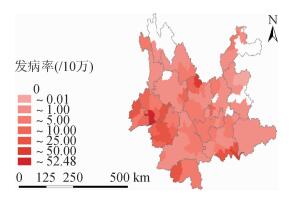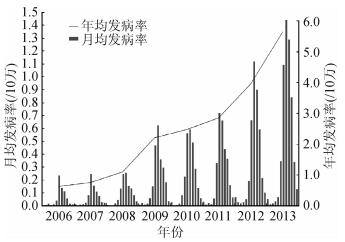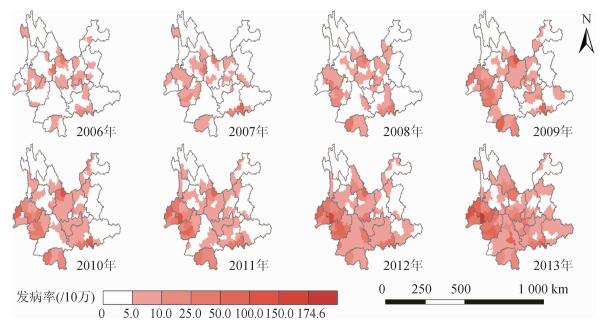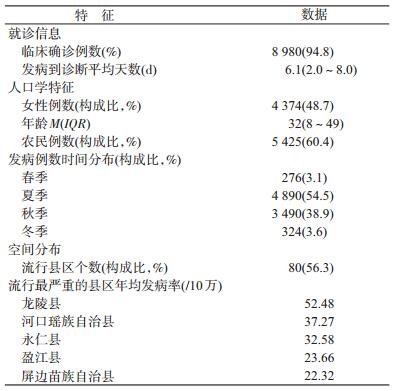文章信息
- 孙烨, 史超, 李新楼, 方立群, 曹务春.
- Sun Ye, Shi Chao, Li Xinlou, Fang Liqun, Cao Wuchun.
- 云南省2006-2013年恙虫病流行特征及影响因素研究
- Epidemiology of scrub typhus and influencing factors in Yunnan province, 2006-2013
- 中华流行病学杂志, 2018, 39(1): 54-57
- Chinese Journal of Epidemiology, 2018, 39(1): 54-57
- http://dx.doi.org/10.3760/cma.j.issn.0254-6450.2018.01.011
-
文章历史
收稿日期: 2017-06-02
2. 250357 济南, 山东管理学院;
3. 100101 北京, 航天系统部疾病预防控制中心;
4. 100071 北京, 军事医学科学院微生物流行病研究所
2. Shandong Management University, Jinan 250357, China;
3. Center for Disease Control and Prevention of Aerospace System, Beijing 100101, China;
4. State Key Laboratory of Pathogen and Bio-security, Institute of Microbiology and Epidemiology, Academy of Military Medical Science, Beijing 100071, China
恙虫病是由恙虫病东方体(Orientia tsutsugamushi)导致、经螨幼虫叮咬传播,以鼠类为主要贮存宿主的自然疫源性疾病[1],广泛流行于亚太地区[2],近年来在我国呈现流行范围增大、流行强度上升的趋势[3-4]。自1956年6月在云南省云龙县媳姑坝证实有恙虫病流行以来[5],该病一直在该省保持较高的流行趋势。本文旨在描述近年来云南省恙虫病流行情况,研究影响其时空分布的环境因素。
资料与方法1.资料数据:云南省2006年1月1日至2013年12月31日恙虫病疫情资料源于国家基础条件平台国家人口与健康科学数据共享平台(http://www.phsciencedata.cn/Share/index.jsp)。云南省各县区人口资料源于2010年第六次全国人口普查数据,县区级行政边界数字地图由国家测绘科学研究院提供。2005年土地覆被数据来自中国科学数据共享平台,空间分辨率为1 km×1 km(http://www.geodata.cn/Portal/dataCatalog/dataList.jsp);2006-2013年各月气象数据由中国气象科学数据共享服务系统提供(http://cdc.nmic.cn/home.do)。
2.分析方法:采用OriginPro 8软件绘制恙虫病疫情时间分布图,应用ArcGIS 10软件绘制地图及提取地理数据。基于县区级行政边界数字地图,在ArcGIS 10软件中应用区域统计方法提取各县区各种土地覆被面积,计算其占各县区总面积的比例,主要包括森林、草地、耕地、灌木面积构成。应用克里金插值的方法对云南省国家级气象站点的2006年1月至2013年12月气象监测数据逐月进行空间插值,应用区域统计方法提取各县区各气象指标均值,主要包括月均温、月降雨量、月均相对湿度、月日照时数。将纳入的影响因素与发病数据建立面板数据表,以县区为一个横断面、月份为时间序列,构建面板数据模型(panel data model),应用Stata 9.1统计软件进行面板负二项回归分析。单因素模型逐个计算变量IRR(incidence rate ratio)并进行统计学检验,入选P<0.05的变量。应用手动逐步回归法将各因素依序纳入多因素模型分析。对纳入的所有变量,以各变量四分位区间(IQR)所对应的月均发病率判断其与发病率之间的线性关系,若存在非线性关系则纳入其二次项进行曲线拟合,如二次项的影响有统计学意义则纳入多因素分析。对变量之间相关系数>0.7的共线性变量仅选入对模型贡献最大者,最终获得云南省恙虫病流行多因素负二项回归分析模型,并估计各因素对恙虫病传播流行的影响[6]。
结果1.流行特征:2006-2013年云南省报告349例恙虫病疑似病例、8 980例确诊病例,其中实验室确诊病例和临床诊断病例分别占5.2%和94.8%,年均发病率为2.46/10万,尤以保山市、德宏傣族景颇族自治州、西双版纳傣族自治州和临沧市高发(图 1),其中年均发病率最高的县区为龙陵县(52.48/10万)(表 1)。2006-2013年云南省年发病率呈显著上升趋势,疫情主要发生于夏秋季,高峰为7-10月,峰值多出现于8月,呈单峰趋势(图 2)。研究期间报告发病区域显著扩大,发病乡镇由2006年的29.5%增至2013年的71.3%,8年间共116个县区(89.9%)有恙虫病疫情报告(图 3)。

|
| 图 1 2006-2013年云南省恙虫病发病率地区分布 |

|
| 图 2 2006-2013年云南省恙虫病疫情流行时间和发病季节分布 |

|
| 图 3 2006-2013年云南省恙虫病发病率县区级时空分布 |
云南省恙虫病高发人群为女性和儿童。其中女性年均发病率为2.49/10万,略高于男性的2.42/10万,患者年龄中位数为32(IQR:8~49)岁,年均发病率最高的年龄组为0~9岁人群(4.80/10万)。其中幼儿(0~2岁)及学龄前(3~5岁)、学龄儿童(6~9岁)的年均发病率分别为4.93/10万、7.04/10万、3.18/10万。除30~39岁年龄组外,其他各年龄组均存在性别分布差异,0~9岁、10~19岁年龄组男性发病率显著高于女性,其中20~29岁以及≥40岁年龄组女性发病率显著高于男性(图 4)。发病人群以农民为主,占总发病例数的60.4%,且呈现上升趋势。病例中所占比例较高的人群还包括学前儿童(22.0%)和学生(11.6%),其中学前儿童发病呈现上升趋势。

|
| 图 4 2006-2013年云南省恙虫病年均发病率年龄、性别分布 |
2.流行相关因素:单因素分析结果表明,耕地、灌木、草地、月均温度、相对湿度5个因素与恙虫病的时空分布具有潜在相关性。多因素面板负二项回归模型结果显示,发病率与相对湿度和月均温度构成呈线性关系,其中相对湿度每增加10%,发病率增加49%(IRR=1.49,95%CI:1.39~1.60,P<0.001),月均温度每上升10 ℃,发病率增加80%(IRR=1.80,95%CI:1.61~2.02,P<0.001)。发病率与耕地、灌木、草地面积的关系为非线性分布,其中发病率与耕地、草地面积呈现“U”形关系,随着耕地和草地面积的增加,发病率先降后升。其中耕地面积一次项的IRR值为0.25(95%CI:0.14~0.47,P<0.001),二次项的IRR值为1.003(95%CI:1.001~1.004,P<0.001);草地面积的一次项的IRR值为0.60(95%CI:0.38~0.93,P=0.022),二次项的IRR值为1.001(95%CI:1.000~1.002,P=0.012);发病率与灌木面积呈现倒“U”形关系,随着灌木面积的增加,发病率先升后降,一次项的IRR值为1.77(95%CI:1.31~2.39,P<0.001),二次项的IRR值为0.999(95%CI:0.998~0.999,P<0.001)(表 2)。
近年来我国恙虫病发病风险较高的县区主要分布在云南和四川省[4]。2006-2013年云南省恙虫病呈现逐年上升、疫源地扩张的趋势,其中2011-2013年全省年发病率增速最快、2008-2009年全省疫区扩张最快,以西部、南部、东南部地区疫情扩张最显著。云南省恙虫病以夏秋季为高峰,主要集中于7-10月发病,峰值多出现于8月,呈单峰趋势。以农民为主要发病人群,农事活动可增加与恙螨的接触机会[7-8]。与我国其他恙虫病高发省份的高发病率人群为老年人不同[9-11],云南省以儿童发病率居高。
作为自然疫源性疫病,恙虫病的流行与自然景观以及气象因素相关。使用面板负二项回归模型分析与发病率相关的环境因素,结果提示发病率随着相对湿度增高、月均温度上升而增加;随着耕地和草地面积的增加,发病率先降后升;随着灌木面积的增加,发病率先升后降。空气相对湿度对恙螨的生长繁殖、地理分布有关键作用[12],与此前所进行的山东、安徽省秋冬型恙虫病[11]、广州市夏秋型恙虫病[13]的研究相符;已往研究常以温度作为影响恙虫病发病率的重要因素[4, 12, 14],在先前的研究中,温度在一定范围内对山东、安徽、江苏省秋冬型恙虫病流行有促进作用,适宜生存温度可以促进主要媒介恙螨和主要宿主黄胸鼠的生长繁殖;植被覆盖类型对恙虫病流行的影响主要体现于对恙螨的生长繁殖和活动性,以及对鼠类种群分布和密度消长的影响。
本文存在局限性。如云南省网络直报病例以临床诊断为主,且由于医疗机构诊断水平和对报告要求的差异,可能存在漏诊、漏报,故存在偏倚;此外文中纳入的环境危险因素并未包括现场调查的鼠类和恙螨分布数据;况且云南省地形复杂,植被类型多样,城乡差别较大,民族分布众多,应在后续研究中应对各地区进行详尽分析。
利益冲突: 无
| [1] | Walker DH. Scrub typhus-scientific neglect, ever-widening impact[J]. N Engl J Med, 2016, 375(10): 913–915. DOI:10.1056/NEJMp1608499 |
| [2] | Kelly DJ, Fuerst PA, Ching WM, et al. Scrub typhus:the geographic distribution of phenotypic and genotypic variants of Orientia tsutsugamushi[J]. Clin Infect Dis, 2009, 48(Suppl 3): S203–230. DOI:10.1086/596576 |
| [3] |
张萌, 王显军, 赵仲堂.
中国恙虫病流行态势及预防控制[J]. 中华流行病学杂志, 2011, 32(4): 419–423.
Zhang M, Wang XJ, Zhao ZT. Current epidemic status and issues on prevention and control of scrub typhus[J]. Chin J Epidemiol, 2011, 32(4): 419–423. DOI:10.3760/cma.j.issn.0254-6450.2011.04.021 |
| [4] | Wu YC, Qian Q, Soares Magalhaes RJ, et al. Spatiotemporal dynamics of scrub typhus transmission in mainland China, 2006-2014[J]. PLoS Negl Trop Dis, 2016, 10(8): e0004875. DOI:10.1371/journal.pntd.0004875 |
| [5] |
危作民, 付良书.
云南恙虫病流行病学调查研究[J]. 云南医药, 1981(5): 28–32.
Wei ZM, Fu LS. Epidemiological study of Scrub typhus in Yunnan province[J]. Yunnan Med, 1981(5): 28–32. |
| [6] | Fang LQ, Wang LP, De Vlas SJ, et al. Distribution and risk factors of 2009 pandemic influenza A (H1N1) in mainland China[J]. Am J Epidemiol, 2012, 175(9): 890–897. DOI:10.1093/aje/kwr411 |
| [7] | Kuo CC, Huang JL, Ko CY, et al. Spatial analysis of scrub typhus infection and its association with environmental and socioeconomic factors in Taiwan[J]. Acta Trop, 2011, 120(1/2): 52–58. DOI:10.1016/j.actatropica.2011.05.018 |
| [8] | Sharma PK, Ramakrishnan R, Hutin YJF, et al. Scrub typhus in Darjeeling, India:opportunities for simple, practical prevention measures[J]. Trans R Soc Trop Med Hyg, 2009, 103(11): 1153–1158. DOI:10.1016/j.trstmh.2009.02.006 |
| [9] | Wei YH, Huang Y, Luo L, et al. Rapid increase of scrub typhus:an epidemiology and spatial-temporal cluster analysis in Guangzhou city, Southern China, 2006-2012[J]. PLoS One, 2014, 9(7): e101976. DOI:10.1371/journal.pone.0101976 |
| [10] | De W, Jing K, Huan Z, et al. Scrub typhus, a disease with increasing threat in Guangdong, China[J]. PLoS One, 2015, 10(2): e0113968. DOI:10.1371/journal.pone.0113968 |
| [11] |
孙烨, 方立群, 曹务春.
山东、安徽、江苏省2006-2013年秋冬型恙虫病流行特征及影响因素研究[J]. 中华流行病学杂志, 2016, 37(8): 1112–1116.
Sun Y, Fang LQ, Cao WC. Study on the epidemiological characteristics and influencing factors of scrub typhus in the autumn-winter natural foci, from 2006 to 2013[J]. Chin J Epidemiol, 2016, 37(8): 1112–1116. DOI:10.3760/cma.j.issn.0254-6450.2016.08.012 |
| [12] | Li TG, Yang ZC, Dong ZQ, et al. Meteorological factors and risk of scrub typhus in Guangzhou, southern China, 2006-2012[J]. BMC Infect Dis, 2014, 14(1): 139. DOI:10.1186/1471-2334-14-139 |
| [13] | Sun Y, Wei YH, Yang Y, et al. Rapid increase of scrub typhus incidence in Guangzhou, southern China, 2006-2014[J]. BMC Infect Dis, 2017, 17(1): 13. DOI:10.1186/s12879-016-2153-3 |
| [14] | Seto J, Suzuki Y, Nakao R, et al. Meteorological factors affecting scrub typhus occurrence:a retrospective study of Yamagata Prefecture, Japan, 1984-2014[J]. Epidemiol Infect, 2016, 145(3): 462–470. DOI:10.1017/S0950268816002430 |
 2018, Vol. 39
2018, Vol. 39




